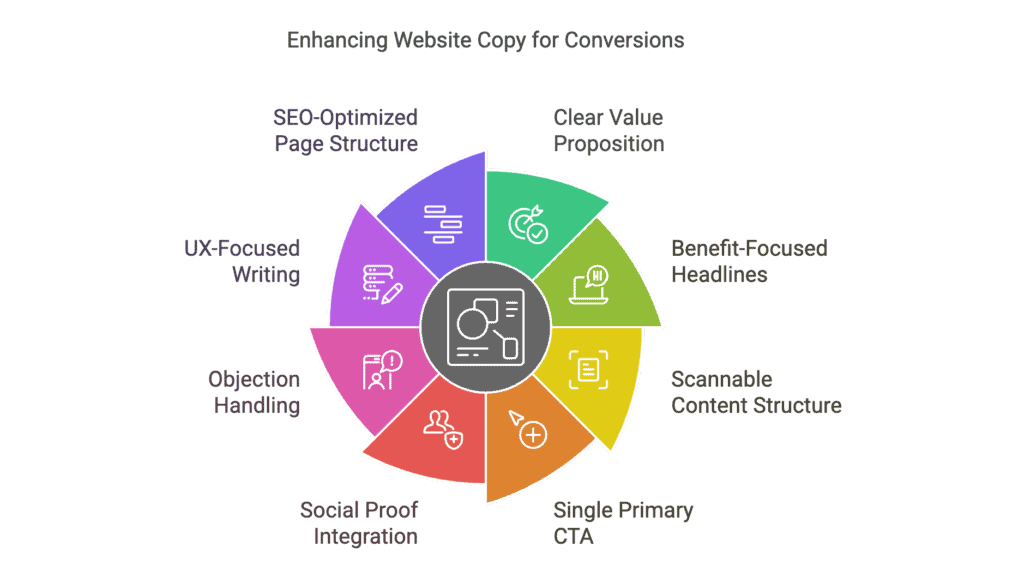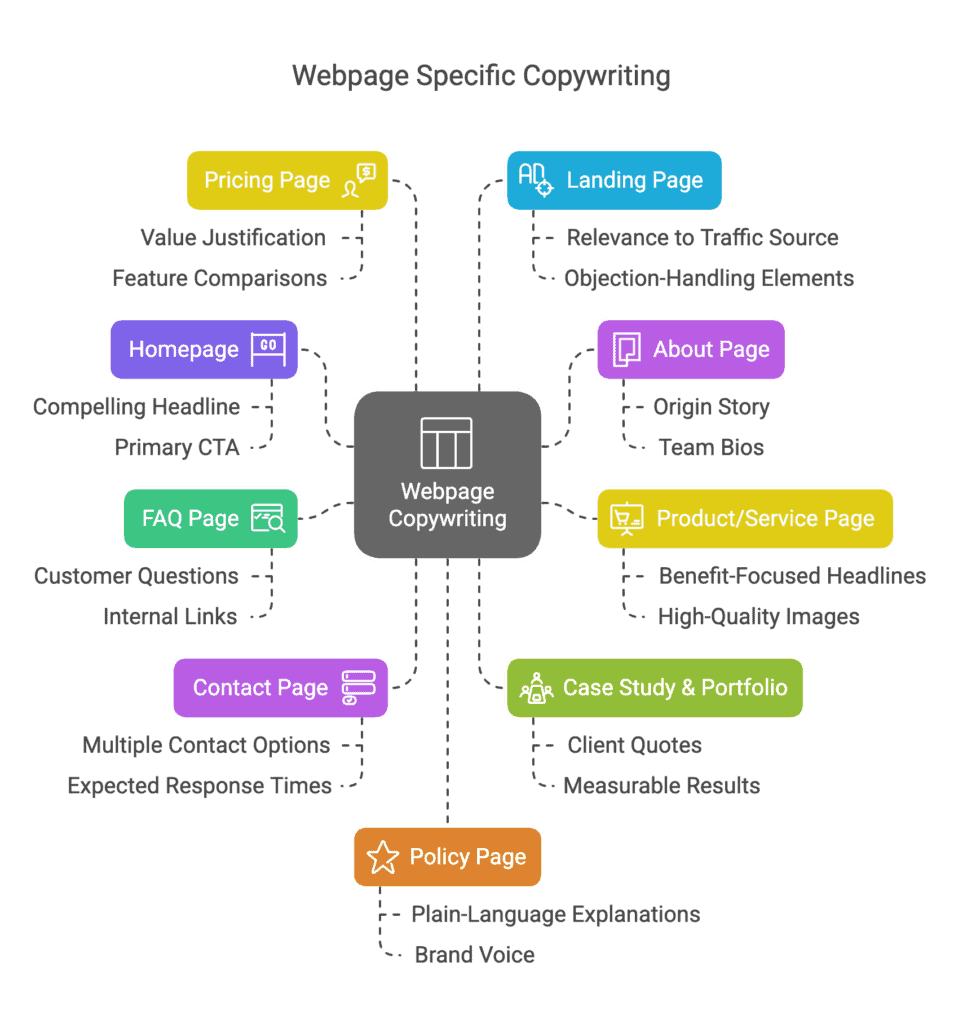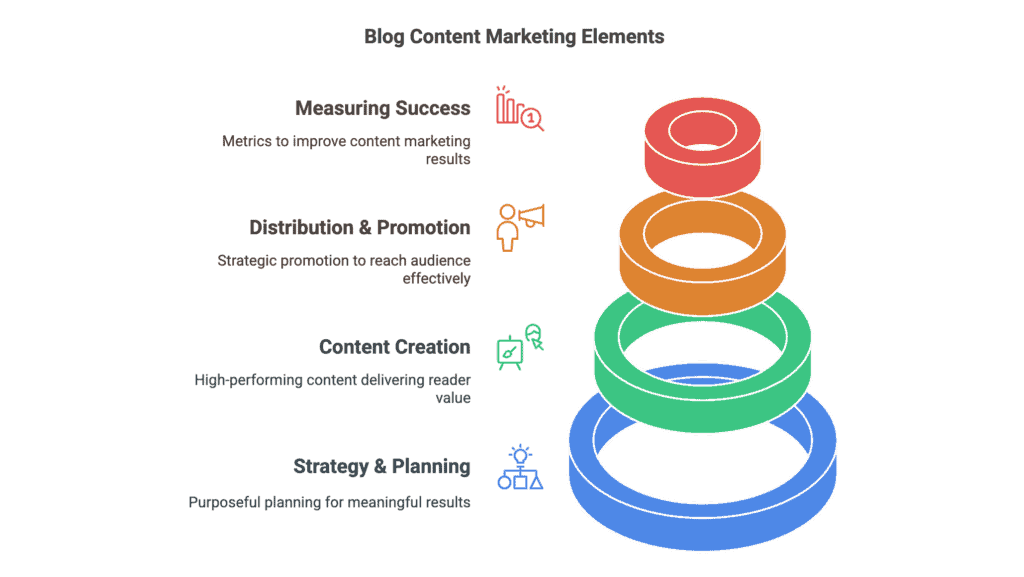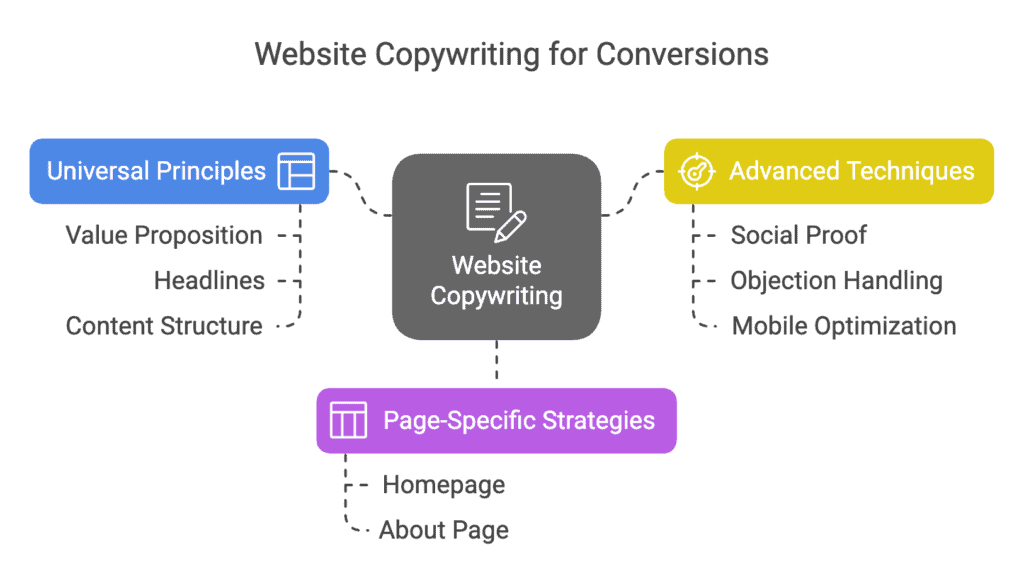In this comprehensive guide, you’ll discover exactly how to create website copy that converts visitors into customers, regardless of your industry or business size.
In this guide, you’ll learn:
- The fundamental principles of high-converting website copy
- Specific strategies for each page of your website
- How to optimize your blog content for maximum engagement and conversions
- Actionable tasks you can implement today (for both beginners and advanced marketers)
Universal Website Copy Principles

Every successful website follows certain copywriting principles that drive conversions. Let’s dive into these proven strategies.
Clear Value Proposition Above the Fold
Your value proposition is the #1 factor determining whether a visitor will stay or bounce. This crucial element needs to be immediately visible without scrolling.
A strong value proposition clearly communicates:
- What you offer
- Who it’s for
- Why it’s better than alternatives
- The key benefit your visitor will receive
The best value propositions are concise (typically under 10 words), benefit-focused, and unique to your brand.
For example, Slack’s value proposition “Where work happens” immediately communicates the core benefit of their platform in just three words.
Beginner Task: Identify your single most important benefit to customers and craft a clear 5-10 word statement that captures it. Place this prominently at the top of your homepage.
Advanced Task: A/B test three different value propositions above the fold, measuring bounce rate and time on page to determine which resonates most with your audience. Use heat mapping tools to see exactly where visitors focus their attention.
Benefit-Focused Headlines (Not Features)
Most businesses make the critical mistake of writing about features instead of benefits. Your customers don’t care about the technical specifications — they care about how your product or service improves their lives.
Transform every feature into a benefit by following this simple formula:
[Feature] + which means that + [Benefit to customer]
For example:
- Feature: “24/7 customer support”
- Benefit: “24/7 customer support means you’ll never be stuck waiting for help when you need it most”
This immediately transforms technical details into meaningful value for your visitor.
Beginner Task: List your top three product/service features, then rewrite each as a benefit statement using the formula above.
Advanced Task: Create customer segments based on your analytics data and develop benefit-focused headlines tailored to each segment. Implement dynamic content on your website that displays the appropriate benefit language based on visitor behavior or source.
Scannable Content Structure
59% of users scan web content rather than reading it word-for-word. Creating scannable content is no longer optional — it’s essential.
Make your content immediately scannable by:
- Using descriptive subheadings (like this guide does)
- Keeping paragraphs under 3 lines
- Utilizing bullet points for lists
- Incorporating strategic bold text for emphasis
- Including relevant images with descriptive captions
- Using numbered lists for processes or steps
Each of these elements creates “entry points” for scanning readers to stop and engage more deeply with your content.
Beginner Task: Review your homepage and break any paragraphs longer than 3 lines into shorter chunks. Add subheadings to any section longer than 100 words.
Advanced Task: Conduct user testing with a tool like Hotjar to record visitor interaction with your content. Analyze where they stop scanning to identify and optimize low-engagement sections.
Single Primary CTA per Page
One of the biggest conversion killers is giving visitors too many options. When you try to promote everything, you end up promoting nothing.
Each page on your website should have:
- A single, clear primary call-to-action
- Visual emphasis that draws attention to this primary CTA
- Supporting CTAs that are visually subordinate to the primary action
Your primary CTA should align perfectly with the visitor’s intent for that specific page. For example, a product page’s primary CTA should be “Add to Cart,” while a blog post might use “Subscribe for More Tips.”
Beginner Task: Identify the single most important action you want visitors to take on each main page of your website. Make this your primary CTA and ensure it stands out visually.
Advanced Task: Implement a conversion rate optimization program testing different CTA placements, colors, and copy. Track micro-conversions (like scroll depth and video views) in addition to your primary conversion metrics.
Social Proof Integration
83% of consumers trust recommendations from peers over traditional advertising. Effective social proof transforms skeptical visitors into confident buyers.
Strategic places to incorporate social proof include:
- Near your primary CTA
- On high-doubt sections (like pricing pages)
- Adjacent to bold claims or statements
- In dedicated testimonial sections
- Within case studies that detail specific results
The most effective social proof is specific, results-oriented, and comes from sources your target audience identifies with.
Beginner Task: Collect 3-5 customer testimonials and add them to your homepage near your primary CTA.
Advanced Task: Create an automated system for collecting customer feedback and dynamically displaying the most relevant testimonials based on the visitor’s industry, company size, or other segmentation factors.
Objection Handling in Copy
Every potential customer has objections before they buy. Addressing these proactively in your copy can dramatically increase conversions.
Common objections include:
- Price (“It’s too expensive”)
- Timing (“I’m not ready yet”)
- Necessity (“I don’t really need this”)
- Trust (“How do I know this works?”)
- Complexity (“This seems complicated”)
Your copy should anticipate and address each of these objections directly. For example, if price is a common concern, include copy that emphasizes ROI or offers payment plans.
Beginner Task: Ask your sales team about the top 3 objections they hear, then add content to your website that directly addresses each one.
Advanced Task: Create an objection map for each customer persona, then develop targeted content strategies for addressing each persona’s specific concerns throughout their customer journey.
UX-Focused Writing Principles
The best website copy works in harmony with design to create a seamless user experience. UX-focused copywriting principles include:
- Using directional cues in language (“Scroll down to see more”)
- Maintaining consistent terminology throughout the user journey
- Writing button text that clearly describes what happens next
- Creating microcopy (small instructional text) that guides users
- Ensuring error messages are helpful rather than frustrating
- Matching language complexity to your audience’s expertise level
Remember that every word on your website either helps or hinders the user experience. There’s no neutral copy.
Beginner Task: Review all your button text to ensure it clearly explains what happens when clicked. Replace vague language like “Submit” with specific actions like “Start My Free Trial.”
Advanced Task: Create a comprehensive UX copy style guide that defines voice, tone, terminology, and writing principles for your entire digital presence. Ensure consistency across all touchpoints.
SEO-Optimized Page Structure
Effective SEO copywriting balances search engine requirements with human readability. The key elements include:
- Strategic keyword placement in H1, H2, and H3 tags
- Natural keyword integration in the first 100 words
- Proper meta title and description implementation
- Internal linking to relevant content
- External linking to authoritative sources
- Semantic keyword usage throughout the content
- Schema markup for enhanced search visibility
Google’s algorithms now prioritize user experience signals like engagement and dwell time over keyword density, so focus on creating genuinely valuable content first.
Beginner Task: Research and identify one primary keyword for each main page on your website. Update your H1 tags and first paragraph to naturally include these terms.
Advanced Task: Create a comprehensive content gap analysis comparing your keyword coverage to top competitors. Develop a content calendar to systematically address these gaps with high-quality, search-optimized content.
Scannable Content Creation
Creating truly scannable content goes beyond basic formatting. It requires a strategic approach to information architecture.
Advanced scannable content techniques include:
- Information chunking (grouping related ideas)
- Progressive disclosure (revealing details gradually)
- Visual hierarchy through typography and spacing
- Strategic use of white space to create visual pauses
- Consistent formatting patterns that create predictability
- Using anchor links for long-form content navigation
Each of these techniques makes complex information more accessible to busy visitors.
Beginner Task: Add a “Table of Contents” to long content pieces, using anchor links to help visitors navigate directly to sections that interest them.
Advanced Task: Implement a content audit focusing specifically on scannability. Rate each page on a scannability scale and prioritize improvements for high-traffic, low-scannability pages.
Mobile-First Copy Considerations
With over 60% of web traffic coming from mobile devices, optimizing your copy for small screens is essential.
Mobile-first copywriting principles include:
- Front-loading important information (no “buried leads”)
- Using shorter paragraphs (1-2 sentences maximum)
- Avoiding wide tables or graphics that require horizontal scrolling
- Creating tap-friendly link areas (not tiny text links)
- Reducing copy length without sacrificing key information
- Using expandable sections for secondary content
Remember that mobile users often have different intent than desktop users — they’re frequently seeking specific information rather than browsing.
Beginner Task: View your website on a mobile device and identify any copy that requires horizontal scrolling or is difficult to read. Simplify this content immediately.
Advanced Task: Analyze your mobile vs. desktop conversion paths to identify friction points specific to mobile users. Develop mobile-specific copy variations for these critical conversion points.
Webpage Specific Copywriting

Different pages on your website serve different purposes and require specialized copywriting approaches. Let’s explore the unique requirements for each page type.
Homepage Copywriting
Your homepage is typically the most visited page on your website. It needs to quickly communicate who you are, what you offer, and why visitors should care.
Effective homepage copy includes:
- A compelling headline that clearly communicates your value proposition
- A subheadline that expands on your primary benefit
- Brief explanations of your core services or products
- Social proof elements (testimonials, client logos, etc.)
- A clear primary CTA that directs to the next logical step
- Secondary CTAs for different visitor segments or needs
- Brief company differentiators that set you apart
The best homepages balance comprehensiveness with clarity, giving visitors enough information to understand your offer without overwhelming them.
Beginner Task: Simplify your homepage copy to focus on your core offering and primary CTA. Remove any content that doesn’t directly support these elements.
Advanced Task: Implement dynamic homepage content that adjusts based on visitor source, geographic location, or return visitor status. Create tailored messaging for each major traffic segment.
About Page Copywriting
Your About page is far more important than most businesses realize. It’s often among the top 3 most visited pages and plays a crucial role in building trust.
Effective About pages include:
- Your origin story (why you started the business)
- Your mission and values in concrete terms
- Real team members with authentic bios and photos
- Specific achievements and milestones with numbers
- Your unique approach or methodology
- A glimpse of your company culture
- A clear next step for engaged visitors
Avoid generic corporate language. Your About page should sound like it was written by a human for humans.
Beginner Task: Rewrite your About page to include a compelling origin story that explains why you’re passionate about helping your customers.
Advanced Task: Create an interactive About page timeline that allows visitors to explore your company history and major milestones. Include rich media elements like video testimonials from long-term team members.
Product/Service Page Copywriting
Product and service pages have the most direct impact on your conversion rate. These pages need to transform interest into action.
Effective product/service pages include:
- Clear, benefit-focused headlines
- Comprehensive feature descriptions tied to benefits
- High-quality images or videos demonstrating the product/service
- Specific use cases or applications
- Technical specifications (when relevant)
- FAQs addressing common objections
- Social proof specific to this product/service
- Clear pricing information (or a path to pricing)
- A prominent primary CTA
Remember that visitors to these pages are typically in the consideration phase, so they need more detailed information than homepage visitors.
Beginner Task: For each product or service, create a list of at least 5 specific benefits customers receive. Update your copy to prominently feature these benefits.
Advanced Task: Create detailed buyer personas for each product/service and develop customized copy that addresses the specific pain points, objections, and desired outcomes for each persona.
FAQ Page Optimization
FAQ pages serve dual purposes: answering common questions and improving SEO through long-tail keyword targeting.
Effective FAQ pages include:
- Questions written exactly as customers would phrase them
- Clear, concise answers that provide genuine value
- Logical grouping of related questions
- An easy navigation system for finding specific answers
- Internal links to relevant detailed content
- Schema markup for potential featured snippet opportunities
- CTAs that direct users to logical next steps based on their question
Your FAQ page should be a living document that evolves based on actual customer questions from support channels.
Beginner Task: Review your customer service emails and support tickets to identify the 10 most frequently asked questions. Add these to your FAQ page using the exact language customers use.
Advanced Task: Implement an FAQ content strategy that targets long-tail question keywords with comprehensive answers. Structure these with proper schema markup to maximize featured snippet opportunities.
Contact Page Copywriting
Contact pages are often overlooked but play a crucial role in conversion. They should make it as easy as possible for visitors to reach you while qualifying leads.
Effective contact pages include:
- Clear instructions on the best way to reach you
- Multiple contact options for different preferences
- Expected response times for each channel
- Brief reassurance about why contacting you is worthwhile
- Simple forms that collect only essential information
- Location information with maps (if relevant)
- Business hours in relevant time zones
The best contact pages anticipate visitor needs and provide answers before they even ask.
Beginner Task: Simplify your contact form to the minimum fields necessary to provide a helpful response. Add a clear statement about when visitors can expect to hear back from you.
Advanced Task: Implement smart contact forms that adjust requested fields based on the visitor’s specific need or query type. Develop automated response workflows for different inquiry categories.
Case Study & Portfolio Pages
Case studies and portfolio pages build credibility by showcasing real results for real clients. They transform abstract promises into concrete evidence.
Effective case study pages include:
- A compelling headline featuring specific results
- Background information on the client’s challenge
- Your approach to solving the problem
- Specific implementation details
- Measurable results with concrete numbers
- Direct client quotes
- Visuals demonstrating the before and after
- A clear CTA for similar prospects
The most powerful case studies follow a classic story structure: challenge, approach, resolution, and results.
Beginner Task: Create a basic case study template and complete it for your most impressive client success story. Include at least one specific numerical result.
Advanced Task: Develop an interactive case study format that allows visitors to explore different aspects of the project based on their interests. Include video testimonials and interactive data visualizations of the results.
Pricing Page Copywriting
Pricing pages are high-stakes real estate that directly impact your bottom line. They require careful balancing of information and persuasion.
Effective pricing pages include:
- Clear, transparent pricing information
- Value justification that supports your pricing strategy
- Feature comparisons between different tiers or options
- FAQs addressing common pricing concerns
- Social proof specifically related to value and ROI
- Risk-reduction elements like guarantees or free trials
- A prominent CTA for each pricing option
Remember that price objections are rarely about the actual number. They’re usually about perceived value relative to that number.
Beginner Task: Add one strong testimonial to your pricing page that specifically mentions the value received relative to the price paid.
Advanced Task: Implement dynamic pricing page elements that highlight different value propositions based on the visitor’s industry, company size, or traffic source. Develop specialized objection-handling content for each major customer segment.
Landing Page Copywriting
Landing pages focus on a single conversion goal and typically receive traffic from specific campaigns or sources.
Effective landing pages include:
- A headline that creates immediate relevance to the traffic source
- Subheadlines that expand on the primary benefit
- Concise benefit statements (usually in bullet form)
- Social proof elements specific to the offer
- A clear, compelling offer with obvious value
- A simple form or button as the primary conversion element
- Objection-handling elements that address common concerns
- Urgency or scarcity elements when authentic
The most effective landing pages maintain message match with their traffic sources, creating a seamless experience from ad to conversion.
Beginner Task: Create a dedicated landing page for your primary traffic source with headline copy that directly matches the messaging in your ads or links.
Advanced Task: Develop a landing page template system that allows for rapid deployment of customized pages for different campaigns, with automated A/B testing capabilities built in.
Policy Page Copywriting
Policy pages may seem purely functional, but they present opportunities to reinforce your brand values and build trust.
Effective policy pages include:
- Clear, plain-language explanations of policies
- Logical organization with descriptive headings
- Summaries of key points for each section
- Visual elements that break up dense text
- Human explanations of technical requirements
- Last updated dates to demonstrate currency
- Contact information for policy questions
While maintaining legal compliance, find opportunities to inject your brand voice and demonstrate transparency.
Beginner Task: Review your privacy policy and add a plain-language summary at the top that explains your data practices in simple terms.
Advanced Task: Create interactive policy pages that allow users to see relevant information based on their location, account type, or specific concerns. Implement version control and change logs for full transparency.
Blog Content Marketing Best Practices

A strategic blog can drive traffic, build authority, and support your overall marketing efforts. Here’s how to maximize its effectiveness.
Blog Strategy & Planning
Random blog posts rarely deliver meaningful results. A strategic approach starts with purposeful planning.
Effective blog strategies include:
- Clear goals tied to business objectives
- Defined audience segments with content tailored to each
- Topic clusters that build comprehensive authority
- Content calendars that ensure consistent publication
- Keyword research that identifies opportunity gaps
- Competitive analysis to find untapped content areas
- Content types aligned with different funnel stages
The best blog strategies balance SEO opportunity, audience interest, and business relevance.
Beginner Task: Define three clear goals for your blog (e.g., “increase organic traffic by 25%”) and create a basic content calendar for the next month with weekly posts.
Advanced Task: Implement a comprehensive topic cluster strategy with pillar content and supporting articles. Develop a content scoring system that evaluates potential topics based on traffic potential, competition, and business value.
Writing High-Performing Content
High-performing content delivers value to readers while achieving your marketing objectives.
Effective blog content includes:
- Compelling headlines that promise specific value
- Introductions that quickly validate the reader’s click
- Comprehensive coverage of the topic with actionable insights
- Original research, data, or perspectives not found elsewhere
- Visual elements that enhance understanding
- Expert quotes or insights that add authority
- Clear next steps for readers who want to learn more
- Strategic internal linking to related content
Remember that the best content creates a gap between what readers knew before and after engaging with your article.
Beginner Task: Choose your most popular blog post and enhance it with additional depth, examples, and actionable tips. Add at least one original graphic or visual element.
Advanced Task: Develop a proprietary research initiative that generates unique data for your industry. Create a content series that explores different aspects of this research, positioning your brand as a thought leader.
Content Distribution & Promotion
Even the best content needs strategic promotion to reach its potential audience.
Effective content promotion includes:
- Social media distribution tailored to each platform
- Email marketing to segmented subscriber lists
- Strategic partnerships with complementary brands
- Paid amplification for high-performing content
- Repurposing content into different formats
- Community engagement in relevant groups or forums
- Influencer outreach for expanded reach
The 80/20 rule applies here: spend 20% of your time creating content and 80% promoting it.
Beginner Task: Create a basic promotion checklist for each blog post that includes at least three social platforms and one email segment. Follow this process for every new post.
Advanced Task: Develop an integrated promotion strategy that includes paid, owned, and earned media channels. Create channel-specific variations of your content optimized for each distribution platform.
Measuring Content Success
Without measurement, you can’t improve your content marketing results over time.
Effective content measurement includes:
- Traffic metrics (users, pageviews, sources)
- Engagement metrics (time on page, scroll depth)
- Conversion metrics (newsletter signups, leads)
- SEO metrics (rankings, featured snippets)
- Social metrics (shares, comments, sentiment)
- Sales impact metrics (influenced revenue)
- Comparative metrics against benchmarks
Focus on metrics that align with your specific goals rather than vanity metrics that may look impressive but don’t drive results.
Beginner Task: Set up basic Google Analytics tracking for your blog to monitor traffic sources, popular content, and basic user behavior.
Advanced Task: Implement an attribution modeling system that tracks how blog content influences sales throughout the customer journey. Develop content ROI calculations that demonstrate the business value of your content marketing efforts.
Conclusion
Effective website copywriting isn’t just about writing well—it’s about strategically communicating value in a way that drives specific actions. By implementing these principles across your website and blog, you’ll create a digital presence that not only attracts visitors but converts them into customers.
The most important step is to start implementing these strategies today. Begin with the beginner tasks for the areas where your website needs the most improvement, then gradually tackle the advanced strategies as you build momentum.
Remember: the best website copy isn’t about clever wordplay—it’s about clear communication that helps visitors understand exactly how you can solve their problems.
